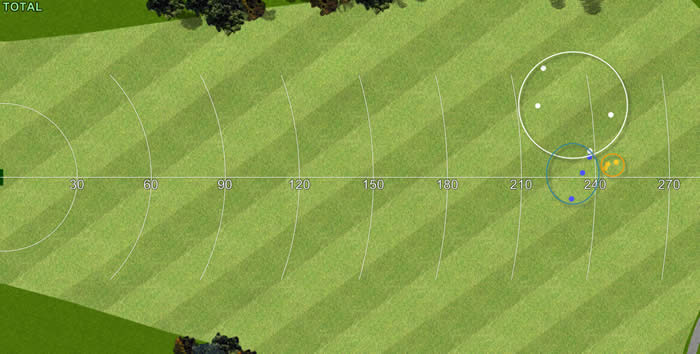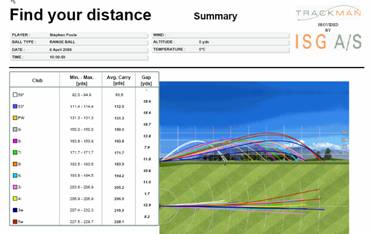It is amazing to me how many golfers that tell me they have had their clubs custom fit to them, but were really fit the old-fashioned way. They go to a location that has a bag of demo clubs, hit a few on the driving range while the club fitter watches their ball flight, and then make a selection based solely on length of the club, lie angle, shaft type, and grip size. I’m sorry, but this is like tuning an automobile engine by listening to the sound and looking at the color of the exhaust. At D’Lance Golf Performance Center, we test our golfers on the latest, state-of-the-art Trackman launch monitors to determine the best club head and shaft combination for them.
The critical factors in performance fitting are:
- Ball Speed
- Launch Angle
- Smash Factor
- Shot Dispersion
- Spin Rate
- Landing Angle
So, how do YOUR stats compare to the pros? See the TrackMan tour averages for ball speeds, launch angles, and more.
Just wanted to let you know that the clubs you built for me are great. I hit more greens and the misses were closer. -Randy W., Eagle, CO 12 Hcp. (November, 2010)
Distance Is All About Ball Speed, NOT Club head Speed
Whenever we get inquiries about fitting, most golfers will give us their club head speed, thinking that will help us determine their shaft flex. Sorry, but this has nothing to do with either shaft flex or distance. Shaft flex, weight, swing weight and stiffness, is determined by each individual’s own shaft loading profile as determined by testing on the True Temper Shaft Lab. Then, to validate these tests, we look for a combination of shaft and head that will optimize BALL speed, not CLUB HEAD speed. Why? Club head speed is a measure of how fast you are swinging the club at impact. This is mostly determined by your physical capabilities (strength and flexibility), your swing mechanics (swing arc and weight transfer), and length of the golf club. Ball Speed is a measure of how well you are hitting the ball on the center of the club face for your given club head speed. Off-center hits can reduce ball speed off the face of a driver by as much as 10-15%. By the same token, with the right shaft length, weight, flex, swing weight and shaft weight, we can actually INCREASE ball speed by as much as 20%! Now, if your ball speed increased by 10 mph, you will conservatively hit that club 20-25 yards farther (every mph in ball speed is roughly 2.5 yards). We easily see golfers pick up a full club distance in their irons and 10% more distance with their woods when they are properly fit.
Smash Factor or Power Transfer Index (PTI)
One of the best ways to determine if you need a new driver or can improve your distance with your old driver is to test it on a launch monitor and look at the Smash Factor or Power Transfer Index. The Smash Factor is the ratio of ball speed to club head speed. For example, with a ball speed of 150 mph and a clubhead speed of 100 mph, your Smash Factor would be 150/100, or 1.50. For today’s modern drivers, we easily see smash factors in the range of 1.5 to 1.55. If they approach 1.60, look out! That club may be illegal! If your driver is over 3 years old, you will probably see low smash factors in the 1.40 to 1.42 range.
When we test golfers on our launch monitors and ball flight monitors, we look at ball speed and the Smash Factor as indicators of how well we are getting the maximum out of a golfer’s equipment. Three factors determine how high we can get the ball speed/smash factor for a golfer:
- How well the golfer hits the “sweet spot” on the club face
- The quality and liveliness of the club face, and
- How well the shaft matches the golfer’s swing profile
When we fit a golfer properly, it is not uncommon for ball speed to increase 4 to 10 mph. Every mph increase in ball speed should result in 2.6 additional yards in carry distance. So, right there, we can increase distance 10-25 yards!
Remember, a well-fit club has you hitting LONGER AND STRAIGHTER shots (less dispersion). Distance comes from longer swing arc (which creates club head speed), hitting the sweet spot of the club (which increases ball speed), a club head that has the capacity to create higher ball speed, and the correct shaft profile (weight, butt AND tip flex). Only a proper, high-tech club fitting can get you dialed in to create more distance, accuracy and consistency.
Launch Angle Optimizes Distance for a Given Ball Speed
The optimum launch angle for both irons and woods is based on ball speed. The following table shows the optimal launch angle for a 6 iron and a driver at certain ball speeds:
| Club | Ball Speed | Optimum Launch Angle | Optimum Back Spin RPM’s |
| MPH | DEGREES | RPM’s | |
| Driver | 120 | 15-17 | 3750-3900 |
| 6 Iron | 85 | 23-25 | 5100-5300 |
The lower your ball speed, the higher you need to launch the ball to obtain maximum carry distance. That is why golfers will sometimes tell me they hit their 3 woods as far or farther than their driver. With a higher launch angle, the ball will stay airborne longer, just like aiming a garden hose a little higher to hit that spot at the back of the garden! By properly testing with the correct head and shaft, our golfers can optimize both their launch angle and ball speed to gain more distance.
Landing Angle Maximizes Roll-Out On Impact
Most launch monitors only measure launch angle and carry distance. The TrackMan ball flight monitor measures descent angle or impact angle to give our fitters an idea of how much roll-out you will get on impact. For a driver, you want your descent angle to be under 40 degrees, preferably 35 degrees or less. This will give you maximum roll-out as long as it matches your launch angle. For a six iron, a good descent angle is around 50 degrees. This will give a good, soft landing with a little roll. Remember, your descent angle MUST match your launch angle to get the best results. The next factor to consider is the spin rate of the ball which has a big impact on descent angle. In general, higher spin rates create higher descent angles, and lower spin rates create lower descent angles.
Optimizing Spin Rates
A lot has to be said about playing the proper ball, club head design and shaft to give you the best possible ball flight. Ball manufacturers have spent a lot of money on research to develop the ball that will give you the longest distance, the best spin characteristics, and the best feel around the greens. Before we go into choosing the best ball for your swing speed, let’s talk solely about spin rates. If a ball did not spin, it would flutter and fall to the ground. If it spins too much, either backspin or topspin, the ball will balloon in mid flight, or take a dive to the ground. For the person that hooks or slices, sidespin is not a good thing. Too much sidespin just makes the hook or slice go farther left or right!
The optimum spin rate is one that gives you good trajectory, optimum carry distance, and the control you want when the ball hits the ground. As we mentioned above, spin rates are affected by ball speed. The higher the ball speed, the higher your spin rates. Optimizing spin rates for drivers requires the perfect combination of club head, launch angle, and shaft profile. Certain driver heads are designed for higher spin rates, as the market is usually a higher handicap golfer looking for more distance. Tour players play heads and shafts that are designed to reduce spin in order to maximize distance and minimize off-center shot dispersion. At D’Lance Golf Performance Center, we test spin rates on both the Golf Achiever and GA CAM systems to determine optimum spin rates. The best way to test is with the ball that you are actually going to put in play. 
Shot Analysis and Club Comparison
D’Lance Golf now offers outdoor fitting using the TrackMan II™ball flight monitor. TrackMan™ is used for development and testing by major golf club, shaft and ball manufacturers in the US and in Japan. TrackMan™ is used by the USGA and the R&A for golf equipment evaluation and testing. Top professionals from the US PGA Tour and the PGA European Tour use TrackMan™ for practicing and optimizing their equipment. TrackMan™ is furthermore used to measure tee shots from the professional players during the world’s greatest professional tournaments.
Outdoor testing is a great compliment to our fitting studios as it allows the golfer to visually see ball flight. TrackMan II™ takes the subjective guesswork out of outdoor fitting by accurately measuring exactly how far your ball is carrying, how far it is off line, the spin rate, and vertical impact angle, which determines how much roll you will get after the ball lands.
We use this system to test your equipment and show you how much improvement in accuracy, distance and shot dispersion you will obtain with the right shaft and head combination. The system can be used for literally every club in your bag.
Check Your Distances
One of the most frustrating things for golfers is to know the exact distances they hit each of their clubs. Are you always coming up short with your Pitching Wedge? Do you seem to hit your 8 iron as long as your 7 iron? Is your Hybrid 4 going longer than your 5 wood? With the Trackman IIä you can check every club in your bag and find out exactly how much gap there is between each club.
The Trackman II™ system is only available for outdoor fitting. To find out where you can get fit using the most accurate ball flight monitor on the market today, contact us at 888-344-5877 888-344-5877
888-344-5877



